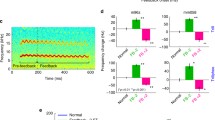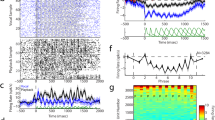Summary
Lesion damage of the anterior midline hemisphere in M. mulatta results in impaired discriminative vocal activity. Destruction of the supplementary motor area (SMA) or pre-SMA greatly increases vocal response latency without similar changes in a non-vocal response. Discrimination and efficiency in performing the vocal and non-vocal responses are unaffected by this damage. The behavioral deficit reflects a specific loss in initiating vocal signals.
Similar content being viewed by others
References
Aitken PG (1981) Cortical control of conditioned and spontaneous vocal behavior in rhesus monkeys. Brain Lang 13: 171–184
Aitken PG, Wilson WA (1979) Discriminative vocal conditioning in rhesus monkeys: evidence for volitional control? Brain Lang 8: 227–240
Baleydier C, Mauguiere F (1980) The duality of the cingulate gyms in monkey. Neuroanatomical study and functional hypothesis. Brain 103: 525–554
DeVito J, Smith OA (1959) Projections from the mesial frontal cortex (supplementary motor area) to the cerebral hemispheres and brain stem of the Macaca mulatta. J Comp Neurol 111: 261–277
Franzen EA, Myers RE (1973) Age effects on social behavior deficits following prefrontal lesions in monkeys. Brain Res 54: 277–286
Glees P, Cole J, Whitty CWM, Cairns H (1950) The effects of lesions in the cingular gyrus and adjacent areas in monkeys. J Neurol Neurosurg Psychiat 13: 178–190
Green HD, Walker AE (1938) The effects of ablation of the cortical motor face area in monkeys. J Neurophysiol 1: 262–280
Green S (1975) Variation of vocal pattern with social situation in the Japanese monkey (Macaca fuscata): a field study. In: Rosenblum LA (ed) Primate behavior. Academic Press, New York, pp 1–102
Jürgens U (1984) The efferent and afferent connections of the supplementary motor area. Brain Res 300: 63–81
Kemp JM, Powell TPS (1970) The cortico-striate projection in the monkey. Brain 93: 525–546
Kirzinger A, Jürgens U (1982) Cortical lesion effects and vocalization in the squirrel monkey. Brain Res 233: 299–315
Künzle H (1978) An autoradiographic analysis of the efferent connections from premotor and adjacent prefrontal regions (areas 6 and 9) in Macaca fascicularis. Brain Behav Evol 15: 185–234
Leander JD, Milan MA, Jasper KB, Heaton KL (1972) Schedule control of the vocal behavior of cebus monkeys. J Exp Anal Behav 17: 229–235
Muakkassa KF, Strick PL (1979) Frontal lobe inputs to primate motor cortex: evidence for four somatotopically organized ‘premotor’ areas. Brain Res 177: 176–182
Myers SA, Horel JA, Pennypacker HS (1963) Operant control of vocal behavior in the monkey Cebus albifrons. Psychon Sci 3: 389–390
Orgogozo JM, Larsen B (1979) Activation of the supplementary motor area during voluntary movement in man suggests it works as a supramotor area. Science 206: 847–850
Pandya D, Dye P, Butters N (1971) Efferent cortico-cortical projections of the prefrontal cortex in the rhesus monkey. Brain Res 31: 35–46
Pandya DN, Kuypers HGJM (1969) Cortico-cortical connections in the rhesus monkey. Brain Res 13: 13–36
Porrino LJ, Crane AM, Goldman-Rakic PS (1981) Direct and indirect pathways from the amygdala to the frontal lobe in rhesus monkeys. J Comp Neurol 198: 121–136
Roland PE, Larsen B, Lassen NA, Skinhoj E (1980) Supplementary motor area and other cortical areas in organization of voluntary movements in man. J Neurophysiol 43: 118–136
Rosabal F (1967) Cytoarchitecture of the frontal lobe of the squirrel monkey. J Comp Neurol 130: 87–108
Seyfarth RM, Cheney DL (1984) The natural vocalizations of nonhuman primates. TINS 7: 66–73
Seyfarth RM, Cheney DL, Marler P (1980) Monkey responses to three different alarm calls: evidence of predator classification and semantic communication. Science 210: 801–803
Smith WK (1945) The functional significance of the rostral cingular cortex as revealed by its responses to electrical stimulation. J Neurophysiol 8: 241–255
Struhsaker TT (1970) Phylogenetic implications of some vocalizations of Cercopithecus monkeys. In: Napier JR, Napier PH (eds) Old world monkeys. Academic, New York, pp 365–444
Sutton D, Jürgens U (1985) Neural control of vocalization. In: Steklis HD (ed) Comparative primate biology. III. Neurosciences. Alan R Liss Inc., New York (in press)
Sutton D, Larson C, Lindeman RC (1974) Neocortical and limbic lesion effects on primate phonation. Brain Res 71: 61–75
Sutton D, Larson C, Taylor EM, Lindeman RC (1973) Vocalization in rhesus monkeys: conditionability. Brain Res 52: 225–231
Sutton D, Samson HH, Larson CR (1978) Brain mechanisms in learned phonation of Macaca mulatta. In: Chivers DJ, Herbert J (eds) Recent advances in primatology. Academic Press, London, pp 769–784
Sutton D, Trachy RE, Lindeman RC (1981a) Primate phonation: unilateral and bilateral cingulate lesion effects. Behav Brain Res 3: 99–114
Sutton D, Trachy RE, Lindeman RC (1981b) Vocal and nonvocal discriminative performance in monkeys. Brain Lang 14: 93–105
Trachy RE, Sutton D, Lindeman RC (1981) Primate phonation: anterior cingulate lesion effects on response rate and acoustic structure. Am J Primatol 1: 43–55
Walker AE (1940) A cytoarchitectural study of the prefrontal area of the macaque monkey. J Comp Neurol 73: 59–86
Woolsey CN, Settlage PH, Meyer DR, Sencer W, Hamuy TP, Travis AM (1952) Patterns of localization in precentral and “supplementary” motor areas and their relation to the concept of a premotor area. Res Publ Assn Nerv Ment D 30: 238–264
Author information
Authors and Affiliations
Rights and permissions
About this article
Cite this article
Sutton, D., Trachy, R.E. & Lindeman, R.C. Discriminative phonation in macaques: effects of anterior mesial cortex damage. Exp Brain Res 59, 410–413 (1985). https://doi.org/10.1007/BF00230922
Received:
Accepted:
Issue Date:
DOI: https://doi.org/10.1007/BF00230922




